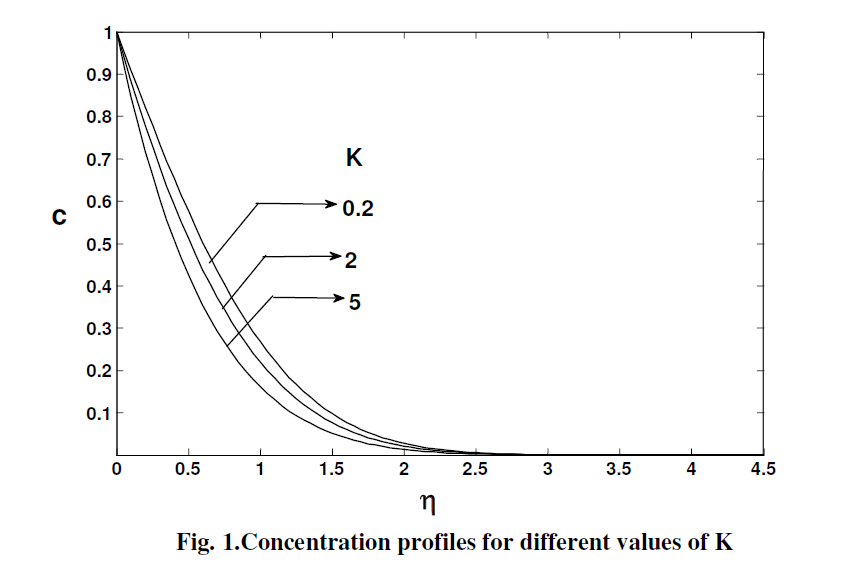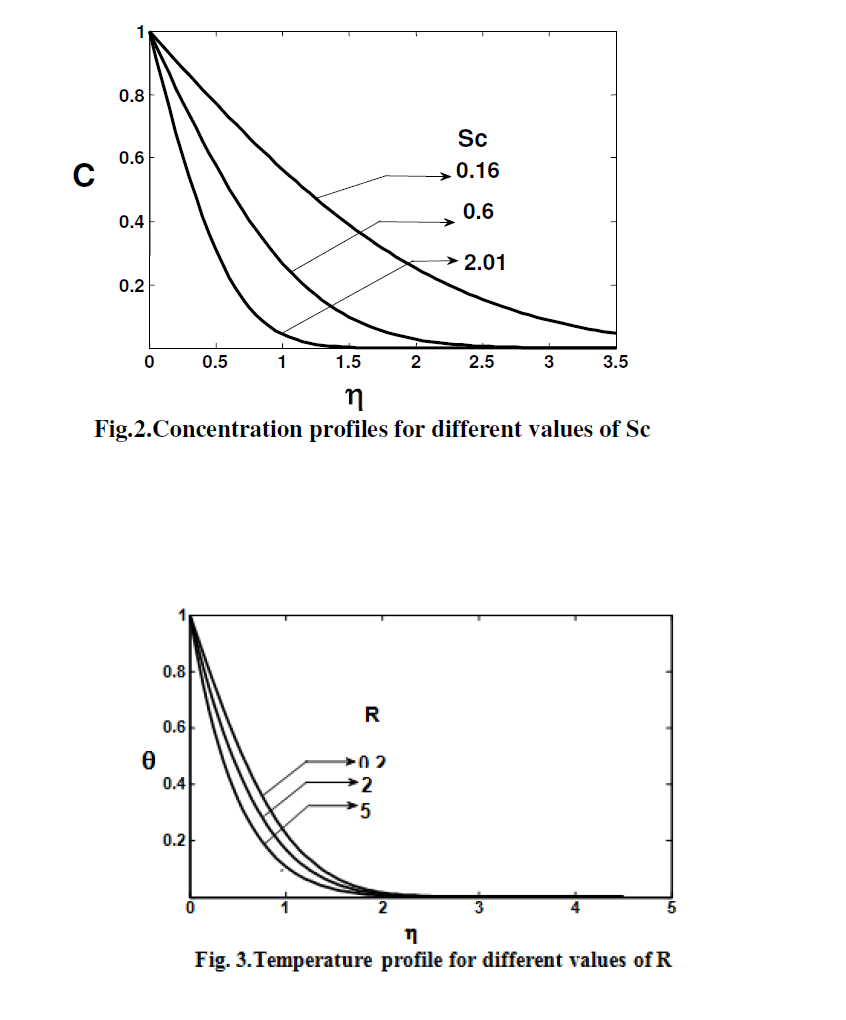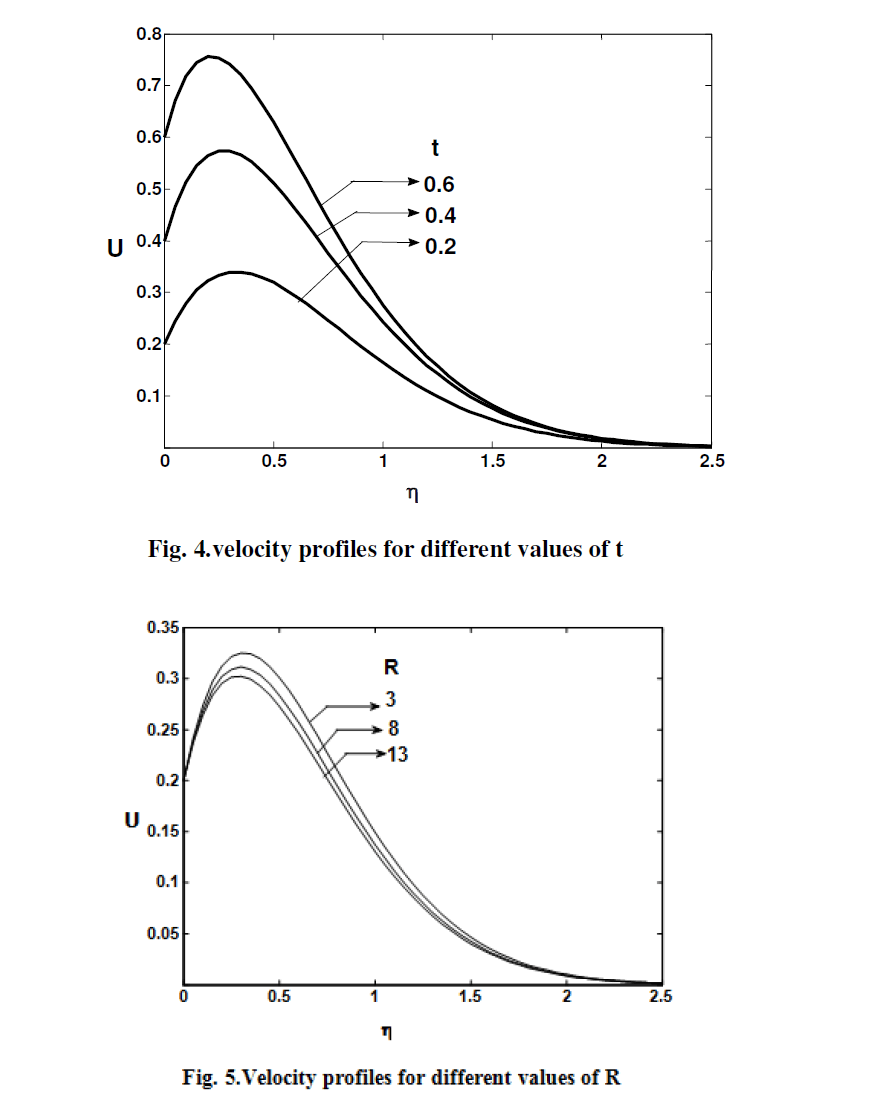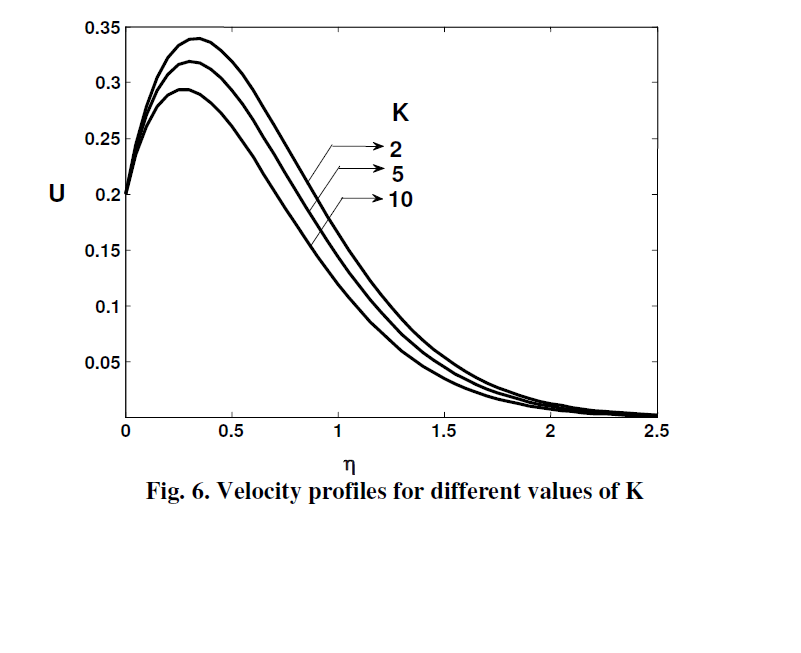ISSN ONLINE(2319-8753)PRINT(2347-6710)
ISSN ONLINE(2319-8753)PRINT(2347-6710)
Geetha.E1,2, Muthucumaraswamy.R3
|
| Related article at Pubmed, Scholar Google |
Visit for more related articles at International Journal of Innovative Research in Science, Engineering and Technology
Theoretical solution of thermal radiation and chemical reaction effecst on unstaedy flow past an uniformly accelerated infinite isothermal vertical plate with uniform mass diffusion, under the action of transversely applied magnetic field has been presented. The plate temperature is raised to Tï· and the concentration level near the plate is also raised to Cï·ï¢ . The dimensionless governing equations are solved using Laplace-transform technique. The velocity , temperature and concentration fields are studied for different physical parameters like magnetic field parameter, radiation parameter, chemical reaction papermeter, thermal Grashof number, mass Grashof number, Schmidt number, Prandtl number and time. It is observed that the velocity increases with increasing values of thermal Grashof number or mass Grashof number. But the trend is just reversed with respect to the chemical reaction parameter. It is also observed that the velocity increases with decreasing magnetic field parameter or radiation parameter.
Keywords |
| Accelerated, isothermal, radiation, vertical plate, heat and mass transfer, magnetic field, chemical reaction. |
I.INTRODUCTION |
| MHD plays an important role in agriculture, petroleum industries, geophysics and in astrophysics. Important applications in the study of geological formations, in exploration and thermal recovery of oil,and in the assessment of aquifers,geothermal reservoirs and underground nuclear waste storage sites. MHD flow has application in metrology, solar physics and in motion of earths core. Also it has applications in the field of stellar and planetary magnetospheres, aeronautics, chemical engineering and electronics. In the field of power generation, MHD is receiving considerable attention due to the possibilities it offers for much higher thermal efficiencies in power plants. |
| Radiative heat and mass transfer play an important role in manufacturing industries for the design of fins, steel rolling, nuclear power plants, gas turbines and various propulsion device for aircraft, missiles, satellites and space vehicles are examples of such engineering applications. England and Emery[1] have studied the thermal radiation effects of a optically thin gray gas bounded by a stationary vertical plate. Radiation effect on mixed convection along a isothermal vertical plate were studied by Hossain and Takhar[2]. The governing equations were solved analytically. Das et al[3] have analyzed radiation effects on flow past an impulsively started infinite isothermal vertical plate. |
| Chemical reactions can be codified as either heterogeneous or homogeneous processes. This depends on whether they occur at an interface or as a single phase volume reaction. In well-mixed systems, the reaction is heterogeneous, if it takes place at an interface and homogeneous, if it takes place in solution. In most cases of chemical reactions, the reaction rate depends on the concentration of the species itself. A reaction is said to be of first order, if the rate of reaction is directly proportional to the concentration itself. Chambre and Young [4] have analyzed a first order chemical reaction in the neighborhood of a horizontal plate. Das et al [5] have studied the effect of homogeneous first order chemical reaction on the flow past an impulsively started infinite vertical plate with uniform heat flux and mass transfer. Again, mass transfer effects on moving isothermal vertical plate in the presence of chemical reaction studied by Das et al [6]. The dimensionless governing equations were solved by the usual Laplace-transform technique. |
| Gupta et al [7] studied free convection on flow past an linearly accelerated vertical plate in the presence of viscous dissipative heat using perturbation method. Kafousias and Raptis[8] extended the above problem to include mass transfer effects subjected to variable suction or injection. Free convection effects on flow past an accelerated vertical plate with variable suction and uniform heat flux in the presence of magnetic field was studied by Raptis et al[9]. MHD effects on flow past an infinite vertical plate for both the classes of impulse as well as accelerated motion of the plate was studied by Raptis and Singh[10]. Mass transfer effects on flow past an uniformly accelerated vertical plate was studied by Soundalgekar[11]. Again, mass transfer effects on flow past an accelerated vertical plate with uniform heat flux was analyzed by Singh and Singh[12]. Basant Kumar Jha and Ravindra Prasad[13] analyzed mass transfer effects on the flow past an accelerated infinite vertical plate with heat sources. |
| Hence, it is proposed to study thermal radiation and hydromagnetic effects on unsteady flow past an uniformly accelerated infinite isothermal vertical plate with heat and mass transfer in the presence of chemical reaction of first order. The dimensionless governing equations are solved using the Laplace-transform technique. The solutions are in terms of exponential and complementary error function. Such a study found useful in chemical proceesing, magnetic control of molten iron flow in the steel industry, liquid metal cooling in nuclear reactors and magnetic suppression of molten semi-conducting materials. |
II.MATHEMATICAL ANALYSIS |
 |
 |
 |
III.SOLUTION PROCEDURE |
| The solutions are in terms of exponential and complementary error function. The relation connecting error function and its complementary error function is as follows: |
| erfc(x) =1- erfc(x)(13) |
| The dimensionless governing equations (9) to (11), subject to the initial and boundary conditions (12), are solved by the usual Laplace-transform technique and the solutions are derived as follows: |
 |
 |
IV. RESULTS AND DISCUSSION |
| For physical understanding of the problem, numerical computations are carried out for different physical parameters Gr,Gc,Sc,K,R,M and t upon the nature of the flow and transport. The value of the Schmidt number Sc is taken to be 0.6 which corresponds to water-vapor. The value of Prandtl number Prischosen such that they represent air (Pr = 0.71).The numerical values of the velocity, temperature and concentration are computed for the above mentioned physical parameters. |
| The concentration profiles for different values of the chemical reaction parmeter (K=0.2, 2,5), Sc=0.6 and t=0.2 are shown in Fig. 1. The effect of chemical reaction parameter play an important role in concentration field. From Fig.1, It is observed that for the larger values of chemical reaction parameter (K = 5,2), the concentration profile rapidly decreases compare to the value of K=0.2.Fig.2 illustrates the effect of the concentration profiles for different values of the Schmidt number ( Sc = 0.16,0.6,2.01) , K=0.2 and t = 0.2 .The profiles have the common feature that the concentration decreases in a monotone fashion from the surface to a zero value far away in the free stream. It showed that the better improvement of the concentration profile for the smaller value of Schmidt number Sc = 0.16, which corresponds to water-vapor, compare to the larger value of Schmidt number ( Sc = 0.6, Sc = 2.01 ). |
| The temperature profiles are calculated for different values of thermal radiation parameter( R = 0.2,2,5 ) at time t = 0.2 and these are shown in Fig.3. The effect of thermal radiation parameter is important in temperature profiles. It is noticed that the temperature of the plate eradically increases for the smaller values of the thermal rediation parameter R = 0.2, R = 2 in the presence of air ( Pr = 0.71 ) and it is better than the value of R = 5. This trend shows that there is a fall in plate temperature dur to higher thermal radiation. |
 |
V.CONCLUSION |
| The theoretical solution of thermal radiation and hydromagnetic flow past an uniformly accelerated infinite isothermal vertical plate in the presence of chemical reaction of first order. The dimensionless governing equations are solved by the usual Laplace-transform technique. The effect of different parameters like thermal Grashof number, mass Grashof number, chemical reaction parameter, radiation parameter, magnetic field parameter and t are studied graphically. The conclusions of the study are as follows: |
| (i) The concentartion of the plate increases with decreasing values of the chemical reaction parameter or Schmidt number. |
| (ii) The plate temperature decreases with increasing values of the thermal radiation parameter. |
| (iii) The velocity increases with increasing values of the magnetic field parameter or chemical reaction parameter or thermal radiation parameter. But the trend is just reversed with respect to the time t. |
VI.NOMENCLATURE, GREEK SYMBOLS |
| C' species concentration in the fluid |
| C dimensionless concentration |
| C w wall concentration |
| C ∞ concentration far away from the plate |
| Cp specific heat at constant pressure |
| D mass diffusion coefficient |
| Gc mass Grashof number |
| Gr thermal Grashof number |
| g accelerrated due to gravity |
| k thermal conductivity |
| K chemical reaction parameter |
| M magnetic field parameter |
| Pr Prandtl number |
| R thermal radiation parameter |
| Sc Schmidt number |
| T temperature of the fluid near the plate |
| T w temperature of the plate |
| T ∞ temperature of the fluid far away from the plate |
| t' time |
| t dimensionless time |
| u velocity of the fluid in the x-direction |
| u 0 velocity of the plate |
| U dimensionless velocity |
| x spatial coordinate along the plate |
| y′ coordinate axis normal to the plate |
| Y dimensionless coordinate axis normal to the plate |
| β volumetric coefficient of thermal expansion |
| β * volumetric coefficient of expansion with concentration |
| μ cofficient of viscosity |
| v kinematic viscosity |
| ρ density of the fluid |
| τ dimensionless skin-friction kg. |
| θ dimmensionless temperature |
| η similarity parameter |
| erfc complementary error function |
 |
 |
 |
 |
References |
|